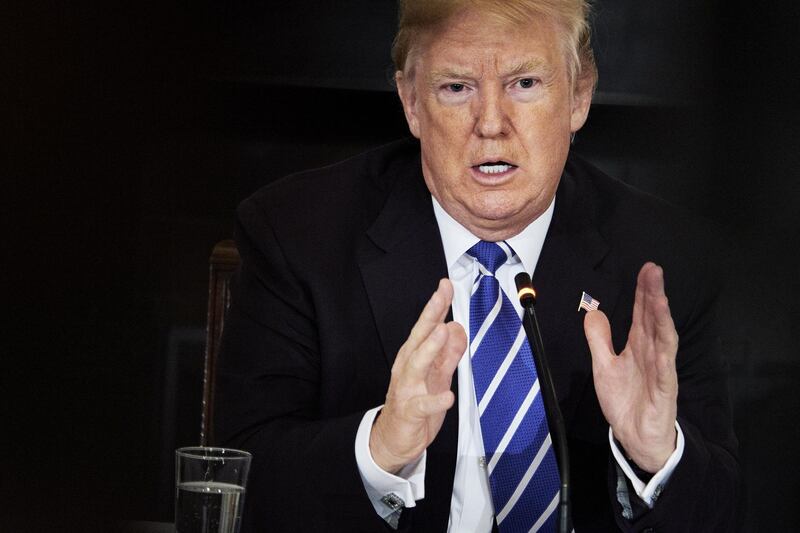President Donald Trump proposed a $4.4 trillion federal budget on Monday for fiscal 2019, a plan Congress is expected to all but ignore that would slash entitlements and other domestic programs in favour of higher spending on the military and immigration enforcement.
Mr Trump again asked policymakers for drastic reductions in environmental, research and diplomatic programmrs he’s long derided as wasteful: a 27 per cent cut to the State Department; 34 per cent to the Environmental Protection Agency; cost-cutting overhauls to Medicare and other social safety-net programmes. That money would be partially diverted toward building a wall on the Mexican border and boosting defence spending.
The Pentagon would see an $80 billion increase in its budget, up 13 per cent. Entitlement programmes would see a $1.7tn cut over a decade, including $237bn from Medicare.
The budget shows the 2019 deficit nearly doubling from projections last year, to $984bn. The red ink would total $7.1tn over the next decade, the national debt would rise to nearly $30tn, and the budget would not balance. That assumes Congress adopts all Mr Trump’s proposals, including spending cuts, and the economy doesn’t suffer a downturn for at least a decade.
Any president’s budget proposal is customarily dismissed by Congress - which controls the government’s purse strings, under the Constitution - as a dead-on-arrival wish list. That’s especially true with this year’s document. Just last week, Congress passed its own bipartisan two-year budget agreement that increased caps for both domestic and defence spending.
The White House scrambled over the weekend to re-write its proposal to account for the deal, only increasing the likelihood that legislators dismiss Mr Trump’s plan. The agreement boosts spending caps by $300bn and provides $90bn in emergency disaster aid.
The congressional agreement on spending caps sets the stage for major increases in both defence and domestic accounts. OMB Director Mick Mulvaney, in a letter accompanying the budget, urged Congress to restrain domestic spending despite the agreement, citing the deficit.
Mr Trump’s budget takes “money that the Democrats want to put to these social programmes and move it to things like infrastructure, move it to things like opioid relief, move it to things that are in line with the president’s priorities so that if it does get spent, at least it gets spent to the right places,” Mr Mulvaney said Sunday on Fox News.
The tax law that Mr Trump signed in December is by itself projected to add more than $1tn to the deficit over the next decade. Domestic spending under the new caps Congress agreed to last week would add $680bn in deficits over 10 years on top of red ink already in the budget, Mr Mulvaney wrote. He proposed spending $57bn less than the new cap.
Congress is all but certain to ignore that advice. Policymakers are already working on a spending bill to meet the new caps and plan to present it to Mr Trump by March 23, the next deadline to fund the government for fiscal 2018.
Fiscal conservatives will be dismayed that Mr Trump’s proposal fails to balance the budget over the next ten years, hitherto Republican orthodoxy. Proposals to gut domestic programs are meanwhile anathema to Democrats.
The president’s infrastructure plan would reallocate $200bn in federal funds over the next decade as seed money to spur states, local governments, and the private sector to finance public works projects. The administration estimates it would create as much as $1.5tn in investments. Ahead of the budget release on Monday, Mr Trump met with state and local officials at the White House to tout the plan.
“We have some very exciting things to be talking about, things you’ve been waiting for for a long time, for many, many years, and now let’s see how badly you want it,” Mr Trump said at the event. “We’re really way behind schedule, we’re way behind other countries. We always led the way for many, many years. Then a number of decades ago it slowed down, and over the last eight years and 15 years, to be honest, it’s come to a halt.”
The budget would dramatically increase US immigration enforcement, a hallmark issue for the president. He wants $782 million to hire 2,750 new border and immigration officers and $2.7bn to detain people who are in the country illegally. Mr Trump also wants $18bn over the next two fiscal years to build a wall on the US border with Mexico - a key point of contention in the ongoing legislative battle over people known as “Dreamers” who were brought to the country illegally as children.
_______________
Read more:
Putin reveals discussions on Mideast with Trump
The US could be heading towards another Cold War
_______________
Mr Trump also envisions increasing spending on deportation proceedings, with the US currently facing a backlog of some 650,000 cases. The proposal calls for $40m to support 75 new immigration judges, and another $40m for 338 new prosecutors at Immigration and Customs Enforcement. Trump would spend $253m to complete a biometric entry-exit system that the administration says would better help identify terrorists and criminals.
The White House envisions a massive $80bn boost to defence spending, by far the largest increase for any federal department. The proposal includes the purchase of new ships for the US navy and calls for adding 24 Boeing F/A-18E/F Super Hornet jets in fiscal 2019 and 110 new jets over the next decade. It would fund 20 new missile defence interceptors and silos, a new “homeland defence radar” in Hawaii and, for the first time, a “salvo” test to fire two interceptors at once at an incoming target.
Mr Trump’s overall national security budget - which includes Energy Department nuclear weapons programmes and defence-related activities at the FBI and smaller agencies - would total $716bn.
The budget once again guts US diplomatic and foreign aid spending, cutting more than 29 per cent - about $17bn - from 2017 levels for the State Department and other international programs.
The administration says that by cutting foreign assistance, the US would promote “self-reliance” among developing countries, ultimately ending their need for aid. The administration also said it would review contributions to multilateral organisations like the United Nations to evaluate if the spending “advances American interests.”
Some programmes do survive the proposed cuts. The administration requests $4.6bn for the protection of American diplomats and staff overseas and $8.2bn to upgrade the State Department’s information technology. The budget also includes continued aid to Israel under the terms of a 10-year agreement reached last year.
And the construction of a new US Embassy in Jerusalem “will be among the Department’s highest priority for capital security investments in FY 2018 and FY 2019,” according to the budget.
Mr Trump requested $13bn in new funding to combat the opioid epidemic, which he has frequently cited as among his top domestic priorities. The president’s proposal includes $50m for an anti-opioid media campaign, $50m for overdose-reversal drugs to be distributed to emergency workers, and $100m for prevention activities, including a state-based programme to monitor painkiller prescriptions. Trump also envisions a $100m public-private partnership between the National institutes of Health and the pharmaceutical industry to develop treatments for addiction, overdose reversal, and non-addictive painkillers.
The proposal also includes $85.5bn in discretionary funding for the Department of Veterans Affairs - nearly a 15 per cent increase, one of the largest in the budget. That includes a 9.6 per cent increase for veterans’ health services and $11.9bn to expand health care options for former service members outside the VA system.
The budget proposes to “transition away from Obamacare” by changing the way Medicaid, the health programme for the poor, is financed. The Affordable Care Act gave states the option to expand the programme, in which spending is now relatively open-ended, to cover more people earning poverty-level wages. Mr Trump would change Medicaid financing dramatically, giving states a choice between a per-person cap on federal payments under the programme or a block grant. Either option would provide a fixed amount of money each year but with fewer federal rules on its use.
Mr Trump also proposes to cut federal payments to home-health agencies and nursing homes by $80bn over a decade and to reduce payments to hospitals by nearly $200bn, including reductions for hospital-owned doctor’s offices.
Funding for US passenger rail would be cut in half under the budget proposal. The Trump budget proposes $738m to fund Amtrak, which requires subsidies for routes that lose money - a 51 per cent cut.
The budget proposes that states step in to help fund money-losing Amtrak service. While revenues are up on the Northeast Corridor between Boston and Washington, most passenger rail service elsewhere in the country loses money.
The comparisons in this article are based on the enacted spending levels for fiscal 2017, the last year that figures for full funding of the government are available. The government has been operating on stopgap funding since October 1, the beginning of fiscal 2018. While the White House provided an addendum to account for the spending deal Mr Trump signed on Friday, numbers for some agencies and programmes may be subject to change.





